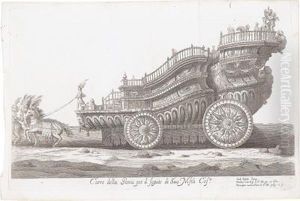Lodovico Ottavio Burnacini Paintings
Lodovico Ottavio Burnacini was an Italian artist known for his work as a stage designer, costume designer, and architect during the Baroque period. Born in 1636 in Orta San Giulio, Piedmont, Italy, Burnacini's career was significantly influenced by the theatrical and artistic environment of the 17th century, which was characterized by elaborate productions and the grandeur typical of the Baroque aesthetic.
Burnacini's father, Giovanni Burnacini, was also an architect and stage designer, which provided the young Lodovico with exposure to the world of theater and design from an early age. This early immersion into the field led to his developing a passion for the stage, and he soon followed in his father's footsteps.
In 1651, the Burnacini family moved to Vienna, where Lodovico's career flourished. He was employed at the Habsburg court, which was then one of the most important and influential cultural centers in Europe. Emperor Leopold I, who had a strong interest in the arts, especially theater, was a patron of Burnacini. Lodovico quickly became the court theater engineer and head of the court's theater decoration workshop.
Burnacini was particularly famous for his work on the theater productions of the court poet, librettist, and impresario Pietro Andrea Ziani and poet Nicolo Minato. His designs for operas, ballets, and other court festivities were known for their opulence and imaginative qualities, often incorporating elaborate machinery, stunning visual effects, and intricate costumes that fascinated contemporary audiences.
His most celebrated work is the stage design for the opera 'Il Pomo d'Oro' ('The Golden Apple'), composed by Antonio Cesti for the wedding of Emperor Leopold I in 1666. The opera was an extraordinary event, and Burnacini's stage design was a significant aspect of its success, reflecting the splendor and magnificence of the imperial court.
Beyond stage design, Burnacini was also involved in architectural projects, although his work in this area is less documented. His contribution to the Baroque stage not only had a significant impact on the development of scenic design in Europe but also left a lasting legacy that would influence the visual arts and theater for generations to come.
Lodovico Ottavio Burnacini passed away in 1707 in Vienna. His work continues to be studied and admired for its inventiveness and its capacity to embody the spirit of the Baroque era in the performing arts.
